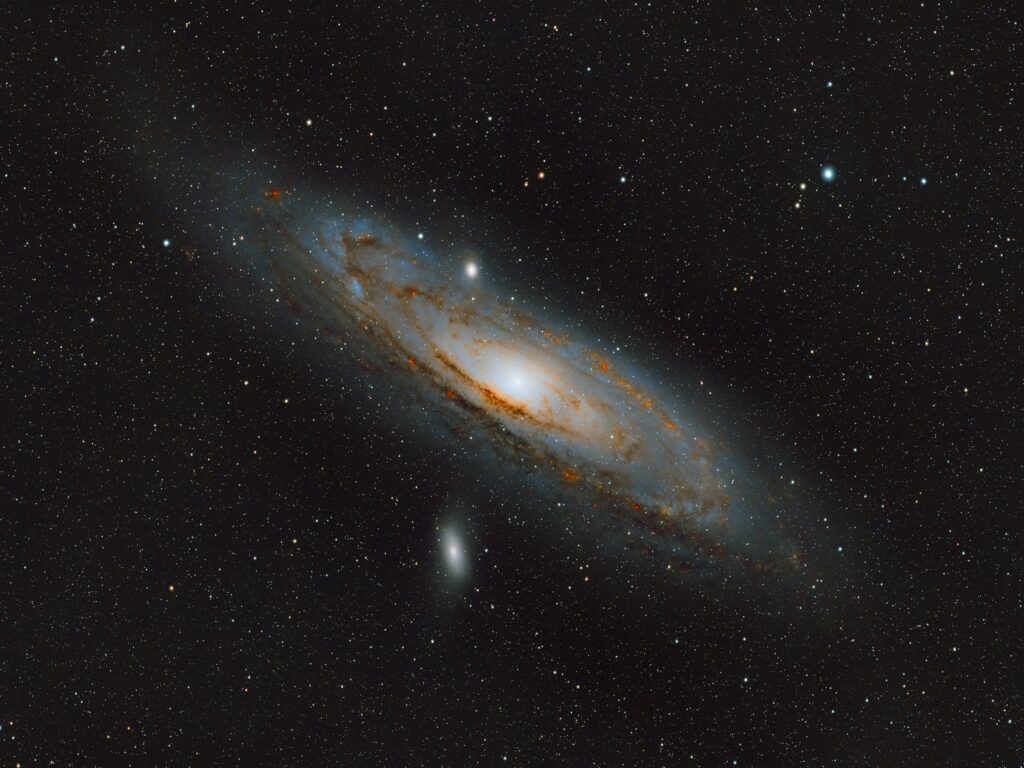Veil Nebula

The Veil Nebula is a supernova remnant in the constellation Cygnus (the Swan). It represents the visible remains of a star that exploded in a supernova thousands of years ago. This vast nebula stretches across an area of sky about 3 degrees in diameter – roughly six times the apparent diameter of the full Moon – making it a large but very faint object in the night sky. This was one of my first targets as an amateur astrophotographer and a challenge to process. Learn more below! Target Details Constellation: Cygnus Distance: 2,400 light years Diameter: 220,000 light years Magnitude: 7.0 Apparent Size: 3.0° x 2.5° RA 20h 45m 38s, DEC +30° 42′ 30″ Shot Details Dates: October 2023 Integration: 116 x 300″ Total Time: 9h 40′ Telescope: Redcat 61 Camera: ASI 2600mc pro Mount: AM5 About the Target The Veil Nebula, also known as the “Cygnus Loop,” is located about 2,400 light-years from Earth and stretches roughly 110 light-years across. What you’re seeing is the expanding debris from a massive star that exploded long ago in a supernova. Even though the nebula is enormous and gives off a good amount of light overall, it’s so spread out that it looks pretty faint in the sky. It was first discovered back in 1784 by astronomer William Herschel — using a reflecting telescope he built himself! The Veil Nebula’s Main Components The Veil Nebula is not a single, uniform cloud, but rather a complex of intertwined nebulae forming different parts of the supernova’s blast wave. Over time, astronomers have identified and named several main components of the Veil Nebula, each corresponding to a bright section of the glowing supernova remnant. The most prominent components are the Western Veil, the Eastern Veil, and Pickering’s Triangle. The Western Veil – “Witch’s Broom Nebula” The Western Veil Nebula (NGC 6960) is often called the “Witch’s Broom” because in photographs it resembles a witch’s broom sweeping through the stars (flipped on the right to the broom “rotation”). This portion appears as a long, slender filament of light stretching roughly north-south on the western side of the Veil complex. A bright 4th-magnitude star named 52 Cygni lies in front of this nebula, but it is not physically related to the nebula. The Western Veil’s filamentary structure consists of fine strands of ionized gas, primarily oxygen and hydrogen. More on the color soon! Its shape is the result of the shock wave from the exploded star expanding through interstellar space, compressing and lighting up the gas. The Western Veil extends nearly a degree in length across the sky. In visual telescopes, this part can be seen as a faint, narrow ribbon of light that stands out well when using filters. The intricate structure and vibrant colors make for an amazing astrophotography target! The Eastern Veil Nebula On the opposite side of the Veil Nebula lies the Eastern Veil, a slightly brighter and denser region of glowing gas. Compared to the Western Veil, this section has a thicker band of nebulosity with more tangled, overlapping threads. These threads are part of the same enormous shockwave from a long-ago supernova — we’re just seeing it from a different perspective. Imagine the explosion as a giant sphere expanding in all directions. Depending on where we’re looking from here on Earth, we’re seeing different parts of that shell from different angles. The Western Veil shows us the edge of the wave, almost like looking at a ripple from the side. But with the Eastern Veil, we’re peering more directly into a section where the shockwave is curving toward or away from us, making the filaments appear more layered and complex. That’s why this region looks more chaotic. Near the top of this section, there’s a feature often nicknamed the “Bat Nebula” because of its shape — it almost looks like a bat with outstretched wings. Altogether, the Eastern Veil spans over a degree of the night sky, which is about twice the width of the full moon as seen from Earth. Pickering’s Triangle Between the prominent eastern and western arcs lies a fainter web of nebulosity known as Pickering’s Triangle. Pickering’s Triangle was first noticed in 1904 on photographic plates taken at Harvard College Observatory. The discovery was made by astronomer Williamina Fleming, but following the custom of the time, it was credited to the observatory director Edward Pickering (hence the name “Pickering’s Triangle”). Pickering’s Triangle appears as a triangular or wedge-shaped network of filaments. It is more subtle than the main east and west arcs, but in long exposures it reveals a stunning tangle of fine, hair-like strands of gas. In images, this region tends to show a mix of soft reds and blues similar to the rest of the Veil, indicating hydrogen and oxygen emissions. Visually, Pickering’s Triangle is the most challenging of the three main sections to observe because of its lower surface brightness, but under dark skies and with a good telescope filter, dedicated observers can trace some of its faint wisps. Other Structures While the Eastern and Western Veil and Pickering’s Triangle are the most famous parts of the nebula, they’re many more small structures. The Veil is filled with many other filaments and small glowing knots scattered across the structure — like the Southeastern Knot, which I annotated above. These aren’t as bright or well-known, but they’re all part of the expanding debris field. Most are little fragments or dense patches of gas that lit up as the shockwave passed through. Think of the Veil Nebula as a giant, hollow bubble from a supernova explosion, the bright filaments are like the edges of that bubble seen from the side. The shockwave isn’t expanding perfectly evenly — some areas hit thicker clouds of gas and light up more brightly, while others drift into emptier space and fade out. The end result is this intricate web of glowing threads spread across the sky, all forming what we call the Cygnus Loop. The Explosive Origin As beautiful
Andromeda

One of my first deep sky objects to image, the Andromeda Galaxy (M31) is the closest spiral galaxy to our own and on a slow-motion collision course with the Milky Way! I captured this image over several nights, stacking hours of exposure time to bring out the fine details of its spiral arms and glowing core. Target Details Constellation: Andromeda Distance: 2.54 million light years Diameter: 220,000 light years Magnitude: 3.4 Apparent Size: 3.2° x 1° RA 00h 42m 44s, DEC +41° 16′ 06″ Shot Details Dates: October 2023 Integration: 158 x 300″ Total Time: 13h 10′ Telescope: Redcat 61 Camera: ASI 2600mc pro Mount: AM5 About the Target Andromeda is an excellent target due to its impressive size in the sky. Surprisingly, from our perspective, it appears four times larger than the full Moon. However, its faint glow makes it difficult to see its sprawling spiral arms with the naked eye. Through long-exposure photography, its stunning structure comes to life, revealing intricate details and the grandeur of this magnificent galaxy. The Andromeda Galaxy (M31) is on a “slow” (244,800 mph) but inevitable collision course with the Milky Way, a cosmic event set to unfold in approximately 4.5 billion years. As the two galaxies are drawn together by gravity, they will engage in a spectacular merger, reshaping their structures and forming a new, larger galaxy. While this may sound catastrophic, Earth itself is unlikely to be directly affected. The vast distances between stars mean that actual collisions between them are improbable. However, the night sky will dramatically change over millions of years, with Andromeda appearing larger and brighter until the galaxies finally blend into one. Visible in my image are some of Andromeda’s most notable satellite galaxies, including Messier 32 and Messier 110. M32 appears as a small, bright elliptical galaxy nestled just above the core of Andromeda, while M110 is seen below Andromeda as a blurry, elongated satellite. These dwarf galaxies, along with others like NGC 147 and NGC 185, are slowly being influenced by Andromeda’s immense gravitational pull and may eventually be absorbed into its structure. Long-exposure astrophotography like this reveals the incredible details of these galaxies, making their presence and interaction with Andromeda all the more striking. The Andromeda Galaxy (M31) is one of the most exciting and rewarding targets for astrophotography, and it was actually one of the first deep-sky objects I ever captured. Its massive size and relatively bright core make it an ideal subject, even for beginners. Unlike many distant galaxies that require large telescopes and dark skies, Andromeda is bright enough to be photographed with a modest setup, making it a common target in the astrophotography community.
